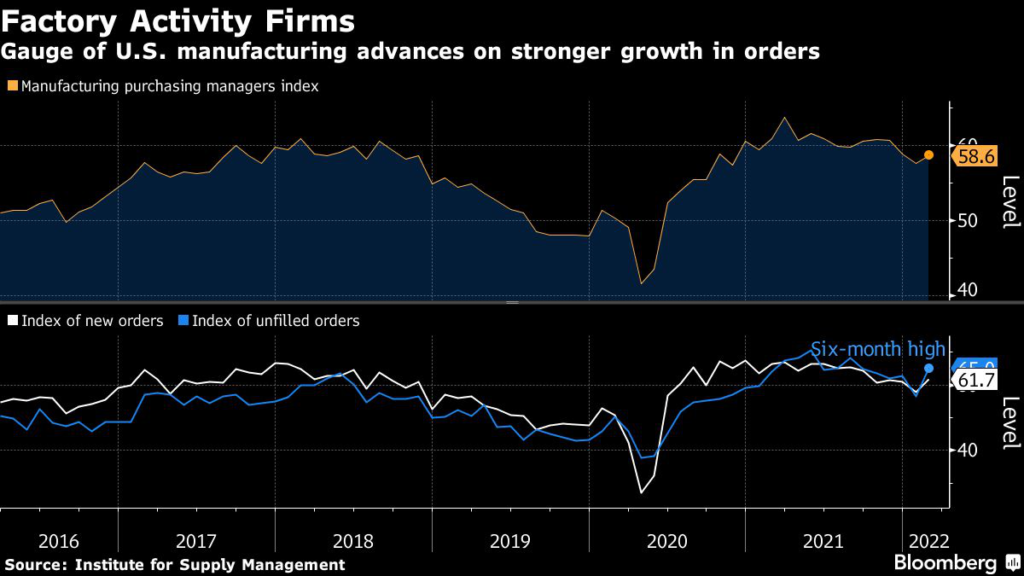(Bloomberg) — U.S. manufacturing activity advanced in February after an omicron-related setback a month earlier, as new orders growth and production accelerated.
The Institute for Supply Management’s gauge of factory activity increased to 58.6 from 57.6 in January, according to data released Tuesday. Readings above 50 indicate expansion. The median projection in a Bloomberg survey of economists called for the measure to improve to 58.
ISM’s new orders measure advanced nearly four points to a five-month high of 61.7 following Covid-19 related softness in January. While production improved, the data highlight how manufacturers are still struggling to keep up with demand for consumer merchandise and business equipment.
The group’s gauge of order backlogs jumped by 8.6 points, the most in 11 years, while supplier delivery times slowed further.
Average lead times in February set record highs in all three categories. For materials used in the production process they climbed to 97 days. Lead times for capital equipment grew to 173 days and for supplies used in maintenance, repairs and operations they rose to 50 days.
“The U.S. manufacturing sector remains in a demand-driven, supply chain-constrained environment,” Timothy Fiore, chair of ISM’s Manufacturing Business Survey Committee, said in a statement. The omicron variant “remained an impact in February; however, there were signs of relief, with recovery expected in March.”
Sixteen manufacturing industries reported growth in February, led by apparel, textiles, paper and transportation equipment.
A measure of prices paid by producers eased from the prior month but may soon move higher as the cost of commodities including crude oil jump with Russia’s invasion of Ukraine. Many manufacturers have passed along higher costs for both materials and labor to consumers, helping to fuel the fastest inflation in decades.
Select ISM Industry Comments
“Electronic supply chain is still a mess.” – Computer & Electronic Products
“Demand for transportation equipment remains strong. Supply of transportation services continues to be a major issue for the supply chain.” – Transportation Equipment
“Coupled with the continuing difficulties in procurement of ocean freight, operational planning and managing costs are our biggest challenges.” – Food, Beverage & Tobacco Products
“Demand for steel products has increased to historic levels, driven by the automotive and energy industries.” – Fabricated Metal Products
“In the automotive area, the microchip shortage is causing slowness in growth.” – Machinery
“We are expecting a year of strong demand, higher prices and continued supply chain challenges.” – Textile Mills
“Production has been more consistent due to availability of parts, but we are not able to increase builds to cut into the backlog.” – Electrical Equipment & Appliances
“Business is still strong. Facing logistics and raw material supply chain issues with some products.” – Plastics & Rubber
The ISM employment index declined to its lowest level since October, though continued to indicate hiring growth in the sector. The government’s monthly jobs report, out Friday, is expected to show manufacturing payrolls increased by 24,000 in February.
Meantime, the group’s gauge of export orders jumped to a one-year high of 57.1, while a measure of imports picked up.
(Adds average delivery times)
More stories like this are available on bloomberg.com
©2022 Bloomberg L.P.











